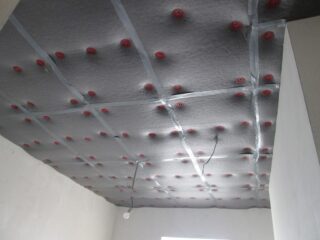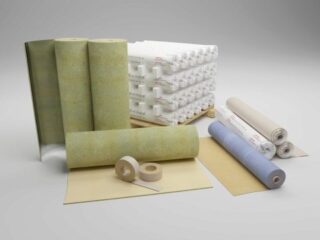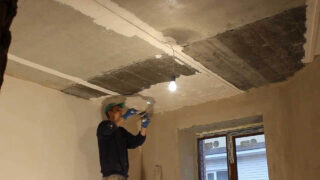Soundproofing a stretch ceiling is an effective and inexpensive way to get rid of the loud sounds of an apartment building. The use of this additional finishing technology will allow you to protect your privacy from neighbors, enjoy watching movies and listening to music, without worrying that it will cause them anxiety. You can make stretch ceilings with sound insulation yourself, saving a good amount on the services of professionals. To make the right decision and install noise insulation under a stretch ceiling without complications, you should familiarize yourself with the assortment, properties and installation rules of soundproofing materials on the market.
Stretch ceiling advantages

Today, stretch ceiling systems are at their peak of popularity in the industrial and private construction sectors.
This is due to the advantages that are inherent in these designs:
- Presentable appearance, perfectly flat and smooth surface.
- A wide range of structure, texture and color gamut of canvases, the ability to produce images to order using photo printing equipment.
- Environmental Safety. The film does not emit harmful substances even under strong heating.
- Quick installation, no wet and dusty work. It is enough to remove objects subject to heating from the room.
- Long service life. For high-quality models, it is 25-30 years old.
- The ability to create complex and beautiful multi-level structures, suspended volumetric figures of the most intricate shape.
- The presence of space between the canvas and the ceiling. It is allowed to place cables, air ducts, internal lamps, auxiliary equipment for controlling household appliances.
- Top leakage protection. PVC canvas can withstand up to 200 liters of water, keeping furniture, things and interior decoration from damage.
- The possibility of multiple dismantling and return to the place of products equipped with a harpoon edge.
One of the criteria that attracts customers is the price of the issue. The tensioning system itself and its accessories are quite affordable.
Materials for noise insulation of the ceiling under the stretch ceiling

The canvas itself and the air above it are already a good soundproofing layer. But it is not able to effectively absorb all the noises typical for the functioning of a large house. To create reliable protection against the penetration of loud sounds from the outside and their exit from the inside, you need to choose the right type of material and its thickness. You need to focus on the height of the walls so as not to lower them to a level where the feeling of comfort and space is lost.
Noise insulation of the ceiling under a stretch ceiling can be performed using the following materials:
- Mineral wool. It is the most effective insulation, which is characterized by ease of installation, excellent insulating properties and an affordable price. It is produced in rolls and mats, made of stone and glass fibers, metallurgical slag. The minus is hygroscopicity, which is fraught with the development of mold in the coating array.
- Expanded polystyrene. It is a material that has proven itself over decades of use in a wide variety of conditions.It is characterized by lightness, low thermal conductivity, elasticity and durability and resistance to moisture. It is produced in the form of slabs 100x100 cm, 2-10 cm thick. It absorbs sounds worse, since it has a solid structure.
- Special fabric. Modern industry has not disregarded this area of construction, as a result of which cellular membranes have been developed. They are distinguished by high performance and ease of installation, which is carried out by gluing to a pre-applied contact layer. Along with this, acoustic materials have proven themselves well, damping waves due to many small holes.
- Bung. This is a substance of natural origin, environmentally friendly, with decent soundproofing qualities. At the same time, the insulation is thin, flexible, elastic, absolutely not susceptible to dampness. There is only one minus - the tangible price of the coating itself and the special glue compatible with it.
Determine the type of soundproofing material and carry out its installation before the installation of the tensile structure. The exception is multi-level structures, when the first stage is the arrangement of the spatial frame.
Preparatory work

After making a decision regarding the installation of a stretch ceiling, a number of preparatory measures should be taken to reduce the cost of arranging the insulation system. First, measurements are made, then calculations, and then the acquisition of everything you need.
For work you will need:
- roulette;
- puncher;
- level;
- a hammer;
- hacksaw;
- paint brush;
- scissors;
- screwdriver;
- even and notched trowel;
- primer;
- insulating tape;
- sandpaper or grater with meshes.
Sound insulation fixing methods are selected based on the design of the tensioning system and the characteristics of the floor. Distinguish between laying in a crate, gluing and screwing. In all cases, it is necessary to prepare the working area for the arrangement of insulation and tension structures.
This event is recommended to be carried out in the following sequence:
- Check the overlap for holes, holes, large irregularities. Smooth the surface, seal the cracks and holes. Remove fragments that do not hold firmly.
- Clean the stove from dust, grease, soot, rust stains. All this is swept away, grinded and washed off by all available means.
- Turn off the light. Remove lighting fixtures. Wrap the ends of the wires with insulating tape.
Finally, cover the slab with a primer. This technique will strengthen its surface and improve adhesion to the adhesive.
Do-it-yourself stretch ceiling installation with soundproofing

Noise insulation of the ceiling in an apartment under a stretch ceiling can be installed using one of three technologies, each of which has its own nuances, features and procedure for implementation.
The frame method is used in cases where the room is so high that lowering it will not give a negative visual effect.
The technique for its implementation is as follows:
- Definition and transfer to the walls of the zero level, along which the wall profile will be installed. As a rule, it drops 2-3 cm lower than the thickness of the insulation.
- Drilling holes at intervals of 50-60 cm, inserting dowels into them, screwing UD profiles to the walls. If the room has a large area, vertical suspensions are attached to the ceiling using a similar algorithm.
- Installation of CD carrier profiles. The distance between them is taken so that the edges of the mats or soundproofing boards are in the center. After removing the horizontal, the profiles are screwed to the plumb lines.
- Transverse parts are installed, and here the distances are adjusted to the format of the insulation. Docking is carried out with cross connectors (crabs).After checking the strength of the structure, the cuts and holes are covered with oil or acrylic paint to prevent the development of corrosion.
Finally, an insulating material is laid on the frame. Soft slabs are installed in spite, and hard ones are connected with gaskets, on sealant or polyurethane foam.
Bonding is much faster and easier, but requires high-quality preparation of the substrate. It must be free of grease and dust. On mineral wool, cork and foam, glue is applied over the entire area with a notched trowel, after which the material is applied according to the markings, pressed down with force and held until the solution grabs.
It is somewhat easier to carry out installation with self-adhesive roll insulators. It is enough to remove the protective film and attach the strip to the ceiling. The investment pays off with the quality of the coating, saving time and effort.
The screwing method is used in cases where large and massive slabs are used to carry out soundproofing of the ceiling in the tension system, or the slab coating is not strong enough to withstand a large weight. The specificity of this technology lies in the fact that it requires at least two people to complete it. One should hold the plate evenly, and the other should screw it to the base. If you work alone, you will have to use glue to fix the fragments on the plate, which is essentially an extra waste. Fastening is carried out with disc dowels, which are driven in at the corners and in the middle. If gaps remain, they are blown out with polyurethane foam, the excess of which, after hardening, is cut off with a clerical knife.
In all cases, a membrane film should be installed under the insulating layer. It will protect the material from moisture, and the stretched canvas - from the falling of small particles of the coating on it.








